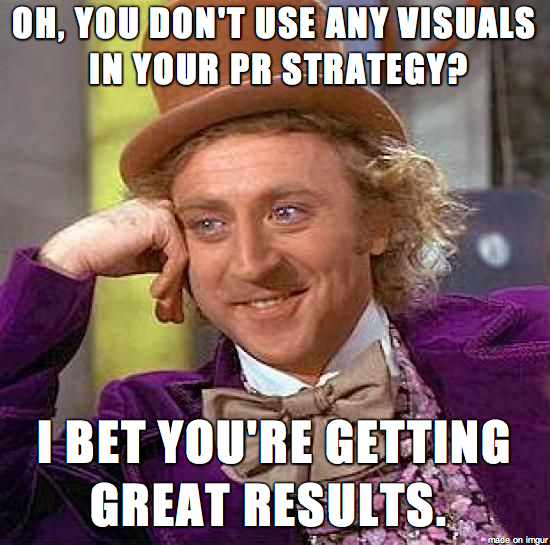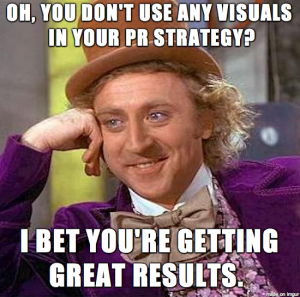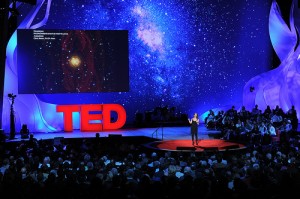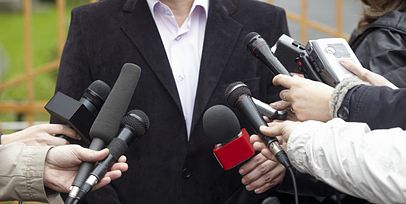Remember when you were a little kid and your parents asked you to pick out a book to read? Did you gravitate toward the one that was a sea of black-and-white letters, or the cool one with lots of colorful, eye-catching photos?
In high school geometry, which was the better textbook? The one that wrote out how to determine the surface area of a trapezoid, or the one that showed you?
Even now, are you more engaged and likely to retain information with presentations that are strictly verbal, or ones that have graphics and charts?
It’s a fact: human beings are visual creatures. As a general rule, we remember 80% of what we see, compared to 20% of what we read and a small 10% of what we hear, a New York University psychological study found.
Applying this to PR, an industry in which the main objective is to communicate positive messages about a brand or person, Wharton School of Business researchers determined that presentations based on visuals were found more compelling and convincing than those that were only verbal.
Furthermore, 67% of the audience in the study said that merging visuals with verbal aids were all the more effective. So how can we, as PR professionals, leverage these findings to the advantage of our brands?
Get Social
With the popularity of visually-driven social media networks like Pinterest and Instagram, there’s no time like the present to socialize your PR strategy.
 Pinterest is especially great since a pin can link directly back to a website. If you pin a PDF of your fresh press release and put some compelling preview text in the description, your audience will not only want to read that particular release, they’ll be taken to your news room, blog, etc. and likely read many more. And check out your team. And explore your website.
Pinterest is especially great since a pin can link directly back to a website. If you pin a PDF of your fresh press release and put some compelling preview text in the description, your audience will not only want to read that particular release, they’ll be taken to your news room, blog, etc. and likely read many more. And check out your team. And explore your website.
In an industry like hospitality, make sure to load your website and e-menu up with lots of great photos showcasing your space, food and amenities. With one click, users will be on your site and one step away from making reservations.
 Instagram isn’t to be forgotten, though. Although it lacks the referral power Pinterest has (at least for now), it’s a great vehicle for furthering community relations efforts or raising awareness of your brand offerings.
Instagram isn’t to be forgotten, though. Although it lacks the referral power Pinterest has (at least for now), it’s a great vehicle for furthering community relations efforts or raising awareness of your brand offerings.
For example, nonprofits can benefit immensely from showcasing their volunteer efforts and positive impact in real time, while a fashion line can post sneak peeks of their new collection and the behind-the-scenes design process to get fans excited to buy.
With a few well-placed hashtags, even non-fans will be in on the action. Networks like Facebook and Twitter, as well as outlets like blogs, can also add to your visual storytelling power in their own unique way.
Create a Better Press Release
Notice I say “create” rather than “write.” That’s because although words still rule in PR, the changing face of the industry requires a little something extra for maximum connectivity and traction from both consumers and media.
As mentioned last year in our piece on putting together a great press release, adding just one photo to a release will increase views by 14%. Applying elements like more photos and video continues the upward trajectory, culminating in 77% higher consumption when visual education tools like infographics come into play.
into play.
This all depends on the industry, too. B2C brands will do well with high-quality photos of their products or properties, while B2B people may be more receptive to charts and graphs.
As with any PR effort, think about your target audience when adding visual elements to collateral like press releases.
Get Ready for Your Close-Up
If you’re not sprinkling video into your PR plan at least occasionally, you should be.
ComScore found that in the US alone, people watch more than a billion online videos every day. Why?
They’re dynamic, typically easy to consume and people equate them with entertainment. Video makes it simple and fun to showcase brand philosophy, spread the word on updates and give a glimpse at the human side of a company, which consumers love.
If you’re trying to rebrand a respected, but traditionally conservative corporation, try a regular feature showcasing employees doing volunteer work or shadowing them for a day on the job. If you’re a tech-savvy company, dabble in mixing up your written press releases with video ones.
Video is also a great tool for media relations. At (W)right On, we’ve had great success creating client b-roll and sending on to news stations for high-quality, late-breaking event coverage – plus, it allows you to pick and choose the footage you want to show off. And, video is a fast way to introduce people to who you are as a company, piquing the interest of potential customers, media influencers and even investors.
What other ways have you found visuals instrumental in a successful PR program? Tell us in the comments or find us on Twitter.








 Grant Wright
Grant Wright





 Corie Fiebiger
Corie Fiebiger
 Shae Geary
Shae Geary Roman Lukjanenko
Roman Lukjanenko Phelan Riessen
Phelan Riessen Katrina Early
Katrina Early Hamish Marshall
Hamish Marshall